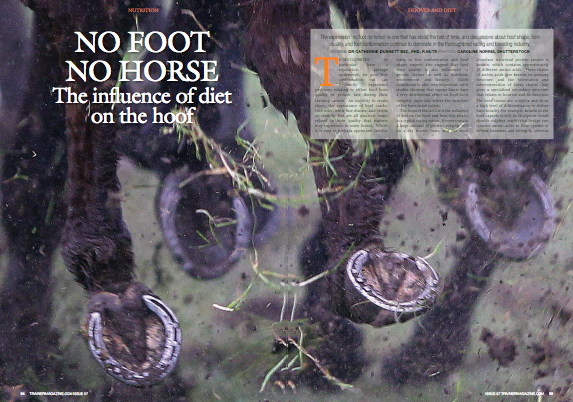Hoof - Surface Interaction Study
By Amy Barstow BVetMed, MRCVS, PhD Candidate
First published in European Trainer issue 58 - July - September 2017
Click here to order this back issue!
In racehorses, the identification of risk factors for lameness has driven research efforts into lameness prevention strategies.
The foot-surface interaction is of particular interest and has been the subject of a lot of research. To date this has primarily been through the investigation of ground-surface composition and properties, in addition to the effects specific surfaces have on the horse’s way of going. Changes in speed, stride length, and frequency have been observed, and the vibrations (shock waves) resulting from the initial foot-surface collision have been measured on different surfaces. However, the surface represents only half the story: what about the foot? In practice it is the foot that we are more likely to influence on an individual level.
As part of my PhD studies at the Royal Veterinary College (RVC), we have investigated whether it is beneficial to use novel farriery techniques such as ‘sole-packing’ and padding materials to improve shock absorption in horses exercising upon both firm and soft surfaces. This work has been kindly funded by the Horse Betting Levy Board (HBLB) and the RVC Paul Mellon Trust. Here we will discuss the intricacies of the foot-surface interaction, what is already known about the effect of surface, and how our research into the use of sole-packing materials might be another arrow to our bow in the prevention of lameness in racehorses.
Developing the young foot
First published in European Trainer issue 58 - July - September 2017
Click here to order this back issue!
I remember my first yearling and two-year-old-in-training sales at Keeneland, Woodbine, and Tattersalls.To my untrained eye, and despite tracing backwards through the bloodlines, each and every horse appeared sound and fit, looking like a million bucks.
Although few horses ever actually sold for that amount, every inch of those young racehorse wannabes was gleaming from nose to toes. Even their feet were buffed and polished as perfectly as a pair of Usher’s coveted shoes.
Possibly because young horses for sale are primped and preened to the gills, few potential buyers actually ever pick their feet up to inspect them. Instead, buyers tend to focus on joints and throats, using the extensive repository to review joint radiographs (X-rays) and scoping prospects’ throats. “The horses in the September (yearling) sales are simply glamorous, including their feet. I would estimate that only 10% of buyers ever actually pick up at foot at those sales,” remarks Sam Christian, a Kentucky-based farrier servicing several top-level operations such as Shadwell Farm.
In general, the expectation appears to be that if the throat and joints are clear and the young horse appears straight, their feet must also be in good condition. While some horses may have hidden surprises once their party shoes are removed (indicating that some of those fancy feet are in fact simply mutton dressed as lamb), Mark Dewey, a highly sought-after racing farrier, attests this is not generally the case.
No foot no horse - the influence of diet on the hoof
CLICK ON THE IMAGE ABOVE TO BUY THIS BACK ISSUE NOW!
First published in European Trainer issue 57 - April '17 - June '17
Hooves and ground surface - the impact of intentional shoeing interventions
The interaction of a horse’s foot and the ground surface is complex. Stance—that part of the stride when the foot is in contact with the ground—can be divided into three phases, which determine the loading environment of the limb: impact, mid stance and push off. Loading of the limb determines how it functions and also influences where injury may occur. Research funded by the Horserace Betting Levy Board at the Royal Veterinary College has focussed on the foot and is allowing a greater understanding of the effect of changes in surface or shoeing on stance, on remodelling of the tissues and ultimately on the risk of injury.





